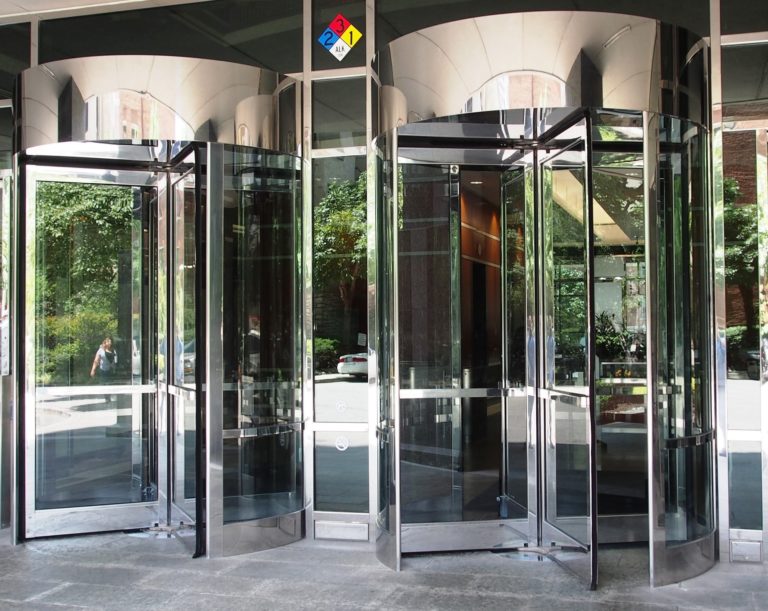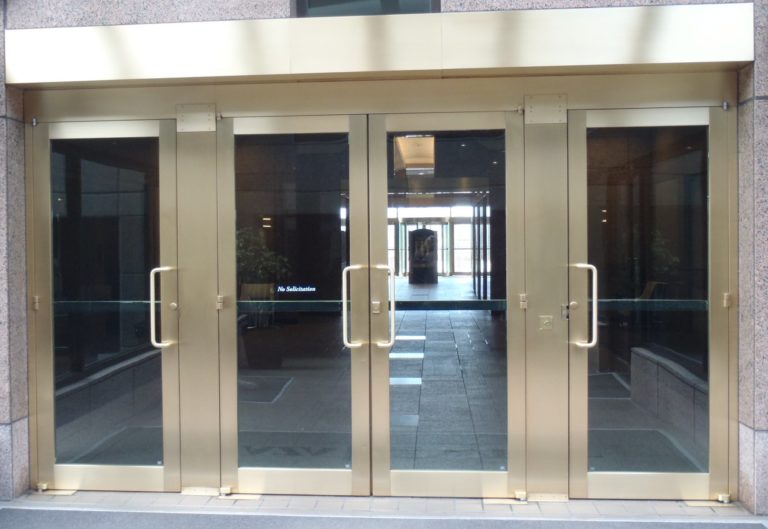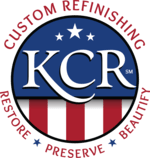
These lacquered stainless steel elevators were cleaned with an ammonia-based product or harsh chemical that breaks down lacquer and causes the streaking you see in these photos.
- Good: This inexpensive product is a favorite of janitorial staff. It can do a good job on mirror-finish stainless steel when used with a soft cotton cloth, not paper towels as they will scratch the surface.
- Bad: Do NOT use on satin-finish metal, bronze or any lacquered surface. Windex contains ammonia which is corrosive to many types of metal.
- Ugly: Windex will break down lacquer and discolor metal.

A SATIN FINISH is less reflective and has a silkier look much like the satin it is named for.

A MIRROR FINISH on a metal surface is more reflective just like a mirror has a more brilliant shine.
- Good: May work on unlacquered mirror-finish bronze for the short term (not recommended).
- Bad: If used, it only works for a short period and therefore needs to be applied daily. Brasso also contains ammonia.
- Ugly: Leaves residue, breaks down lacquer, and causes discoloration.
| WHAT IS LACQUER? This protective clear coat provides a barrier between metal and the oil on fingers, or stains and minor scratches. |
- Good: Can work on stainless steel if applied with a microfiber cloth wiped in the direction of the metal’s grain.
- Bad: May cause build up or be runny.
- Ugly: Some aerosol cleaners are not oil-based and will remove the oil barrier leaving the metal surface very streaky.
| WHAT IS A MICROFIBER CLOTH? These ultra-soft cloths are made with synthetic fibers that are finer than a strand of silk or a human hair. They can be found in stores from Walmart to Home Depot or online at Amazon. | METAL HAS A GRAIN? If you look closely, you will see a uniform pattern of lines or striations much like you’d see in a plank of wood. When cleaning, your back and forth wiping should “go with the grain” and match the motion of those grain lines. |
- Good: There is NOTHING good about ABRASIVES on metal.
- Bad: Abrasives will damage finish and can cause scratching
- Ugly: It will cost you money to refinish unnecessarily.
 PROFESSIONAL REFINISHING
PROFESSIONAL REFINISHING
- Good: It keeps your building looking new and well cared for. A refinish is a service where professional technicians restore the finish of the metal by cleaning, removing scratches that went beyond any protective lacquer, and realigning the grain giving that fresh appearance that equates to a property’s better impression.
- Bad: It is more expensive than cleaning products, but less expensive than replacing your metal.
- Ugly: Don’t let a sales person tell you every metal surface should be refinished annually. Pieces that are constantly touched, like handles, may need more frequent refinishing, but other surfaces that aren’t touched, like entrances, could last up to two years or more before refinishing.
- Good: A maintenance visit by technicians from a refinishing company ensures the metal is getting the proper cleaning and wax needed to maintain its appearance between refinishing services. It also delays the need for refinishing. Maintenance is often scheduled quarterly. However, annual contracts can divide the cost into monthly payments, which can be easier on your budget.
- Bad: It’s a win-win situation: nothing bad about it.
- Ugly: Beware those vendors who make promises but don’t complete maintenance appointments as it hastens the need for a more expensive refinishing service. A good refinishing partner knows the value of proper maintenance.
